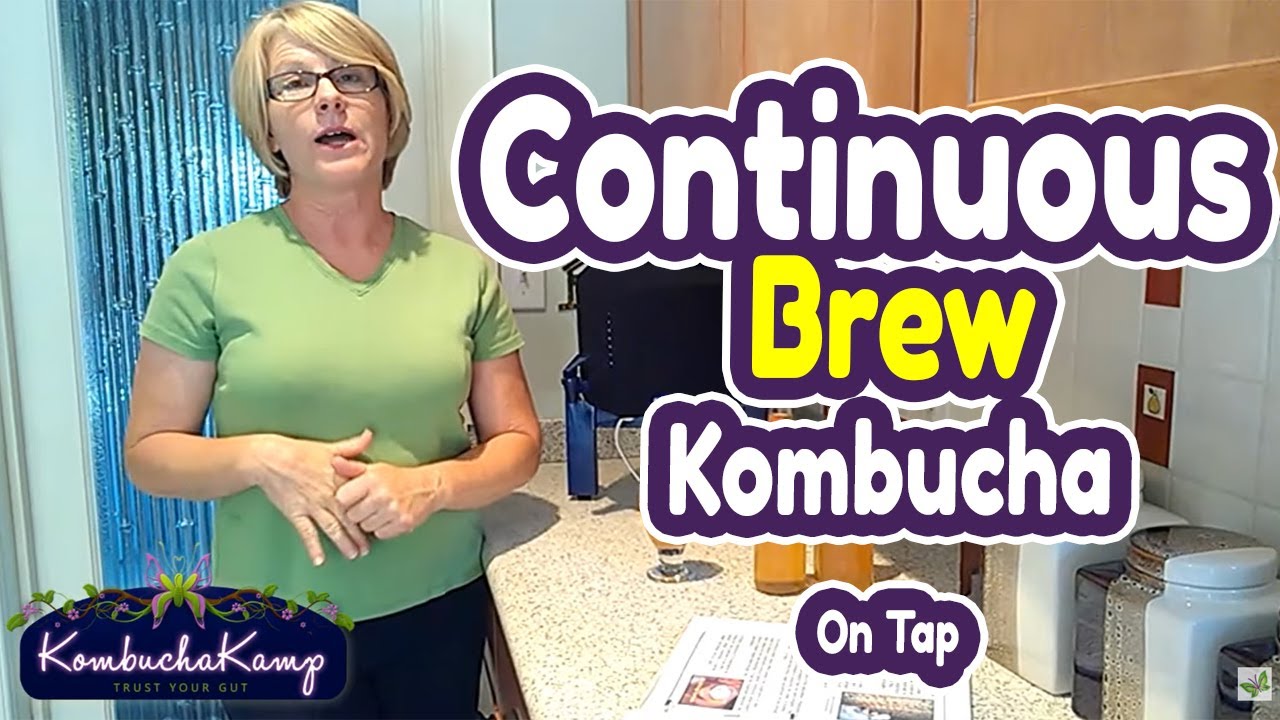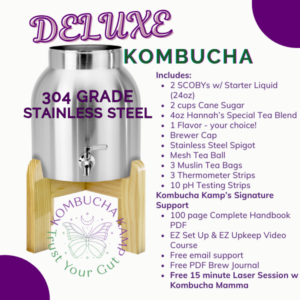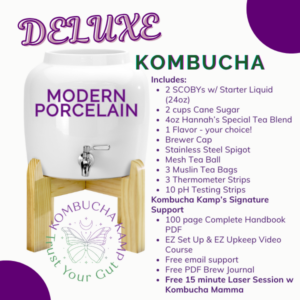
Curious to learn which Kombucha brewing method is best for flavor, consistency, and health benefits in 2026? Look no further than our definitive 2026 Expert 1st Fermentation Guide to Continuous Brew (CB) Kombucha – the most comprehensive of its kind online from the industry leader in Kombucha Starter Cultures and Fermentation Education.
Home fermentation has come a long way since the early 2000s kitchen experiments that launched the modern Kombucha movement. In 2026, more brewers than ever are looking for ways to make healthy, delicious, low-waste kombucha at home — and one question continues to surface:
Should you use the Batch Brew method or switch to Continuous Brew?
This guide breaks down both styles in detail — how they work, what makes them different, and why Continuous Brew has become the preferred method for most home brewers today.
Batch brewing is the traditional method of making Kombucha and involves – you guessed it! – brewing Kombucha in single batches! But it is important to note that this type of brewing is not best suited for large batches and those looking to enjoy Kombucha with their families or every day. Let’s break down the Batch Brewing process:
It’s simple, approachable, and gives you full control over every brew cycle! And because it is so simple, it’s easy to bring into dorm rooms, bedrooms, smaller kitchens, RVs, and so much more without worrying about long term storage or commitment. It’s also an easy way for beginners to dip their fingers into home fermentation safely, easily, and with very low cost! (Our Kickstarter Kombucha Kit makes an excellent gift for graduates, health nuts, foodies, and science nerds alike! And it’s a great way to teach kids about the fun of fermentation!)
Easy to start — perfect for beginners.
Simple equipment: a 1-gallon jar and cloth cover.
Allows experimentation with different teas and sugars.
Labor-intensive: you must clean and restart every cycle.
SCOBYs can become stressed from drastic environment changes.
Long gaps between batches mean inconsistent flavor and carbonation.
Continuous Brew (CB) is a more advanced system where you maintain a single live culture that ferments continuously in the same vessel. But just because it’s called “advanced” doesn’t mean it’s difficult! In fact, most people who enjoy Kombucha in their homes find this to be far easier – and certainly cheaper over time – than continuously stocking their homes with expensive commercial brands.
So how does Continuous Brew stack up to Batch Brew? Instead of starting over each time, you:
Less cleaning & maintenance: no need to handle the SCOBY between batches.
Consistent flavor: the culture remains active and balanced.
Enhanced health benefits: continuous fermentation supports stronger acids and a richer probiotic profile.
Safer brewing: the thick, mature culture and low pH deter mold and contamination.
Slightly higher upfront cost (requires a spigot vessel).
Harder to measure exact brew time for each draw.
May require a heating system in cooler months.
Continuous Brew isn’t just a convenience upgrade — it’s the natural evolution of Kombucha brewing. And it makes a daily Kombucha habit something within reach for anyone looking to take control of their gut health for pennies per glass!
Modern brewers prefer it because it better replicates how Kombucha has been made for centuries: as a living, continuous ferment rather than a series of isolated batches. Below are some of the biggest benefits to brewing Kombucha via Continuous Brew:
A continuously fed culture creates a dynamic microbial ecosystem that supports more balanced yeast and bacteria ratios — meaning improved gut health potential. This also means you’ll have more consistent results and flavors since you will be continuously brewing with the same symbiotic culture that you started with.
The low pH (typically 2.8–3.2) prevents harmful microbes from thriving. Once established, a Continuous Brew system becomes nearly self-regulating. This means you can ditch worrying about mold (for the most part – check out our Guide to Identifying Kombucha Mold if you want to see if your brew is funky.)
No need to constantly heat, clean, and restart new jars. You use less energy, water, and cleaning supplies — and your SCOBY thrives instead of being stressed. Think of Continuous Brew Kombucha as the grown up version of Batch Brew… it’s older, has a house with a garage, and can relax in its own space indefinitely!
| Feature | Batch Brew | Continuous Brew |
Setup Cost | Low | Moderate (spigot vessel) |
| Maintenance | High | Low |
| Safety | Moderate | High (lower mold risk) |
| Flavor Consistency | Variable | Stable, predictable |
| Yield Frequency | Every 7-14 days | Daily or weekly |
| Probiotic Density | Moderate | Higher |
| Learning Curve | Beginner-friendly | Easy after setup |
| Best For | Experimenters | Daily drinkers & families |
Choose the Right Vessel
Use a porcelain, glass, oak barrel, or stainless steel vessel with a lead-free spigot.
Avoid plastic or metal taps (except 316 stainless).
We recommend Kombucha Kamp Continuous Brew Vessel Kits
Add Your SCOBY & Starter Liquid
Fill about 25% of the vessel with mature Kombucha from a previous batch.
Add your healthy SCOBY.
Brew Sweet Tea & Fill Vessel
1 cup sugar per gallon of tea (organic cane sugar is ideal).
Steep 4–6 tea bags or 2 Tbsp loose leaf per gallon.
Ferment for 7–10 Days
Keep out of direct sunlight and between 75–85°F (24–29°C).
Use a Kombucha Heating Mat or Fermentation Wrap if needed. These are ideal for colder climates or in-home locations where temperatures tend to vary throughout the day. They can be a bit pricey, but they are well worth the investment if you want to have a consistent supply of Kombucha year round without long wait times.
Taste Test & Draw Off
Once it reaches your desired balance of sweet and tangy, open the spigot and fill bottles. You can also drink a cup and replace a cup, but we absolutely swear by the “decant a gallon, replace a gallon” method for saving time and giving yourself some extra to test 2nd fermentation recipes and find flavors you really love.
Replace What You Took
Immediately add the same volume of fresh sweet tea.
That’s it — your system runs indefinitely!
Years! Many brewers keep the same system active for 5+ years with proper care.
Only every few months or if you notice excess yeast buildup. Otherwise, the ecosystem stays balanced naturally.
Stick to plain tea for the base brew. Add flavorings only during bottling (2nd fermentation).
Replace no more than 25–35% of the total volume at once to maintain microbial balance
The best part of CB is that you can always have fresh Kombucha ready to flavor. That means you’ll always have some on hand for making quick gifts, seasonal sips, or booze-free beverages for any occasion!
Try these seasonal combinations when bottling:
Spring: Strawberry + Basil
Summer: Mango + Lime
Autumn: Apple + Cinnamon
Winter: Cranberry + Orange Peel
(See our Kombucha Flavoring Guide for 10 Easy Recipes for Flavoring Kombucha.)
| Task | Frequency | Why It Matters |
| Draw & Refill | Weekly | Keeps brew active & balanced |
| Check pH (Target 2.8-3.2) | Monthly | Ensures safety & flavor |
| SCOBY Inspection | Every 2-3 Months | Remove excess yeast |
| Full Clean & Reset | Every 6-12 Months | Refresh Ecosystem |
Kombucha Kamp pioneered the Continuous Brew revolution, empowering tens of thousands of home brewers worldwide. Hannah Crum, Founder of Kombucha Kamp and author of Bestselling Book The Big Book of Kombucha, has spent her career advocating for strict standards including commercial brewing and has been instrumental in bringing Kombucha to store shelves with the highest quality cultures and rigorous testing available.
Our Complete Continuous Brew Systems include everything you need:
✅ Handcrafted porcelain or stoneware vessel
✅ Live SCOBY & starter tea
✅ Organic tea blend and sugar
✅ Brewing cloth & rubber band
✅ Digital Quickstart Guide
With step-by-step videos, lifetime support, and over 20 years of brewing expertise, we make it simple to enjoy consistent, delicious Kombucha every day.
While both methods have their place, Continuous Brew offers unmatched convenience, safety, and probiotic potency.
For new brewers, it eliminates frustration and guesswork. For experienced fermenters, it opens the door to endless creativity — all while honoring Kombucha’s ancient roots as a living, evolving drink.
If you’re ready to simplify your brewing routine and upgrade your gut health, Continuous Brew is the future of Kombucha in 2025 and beyond.




Drink a cup, add a cup! It really is that simple, however we typically “decant a gallon, add a gallon” to streamline the process.
First, we brew up a larger batch of Kombucha or JUN right in the vessel following Kombucha Kamp’s signature Shortcut Method™.
Then after 2-4 weeks of fermentation – tasting frequently from the handy dandy spigot – when the brew is ready to harvest, we simply decant it through the spigot directly into our bottles. Look ma, no mess! No heavy jars to lift!
Once the brew is established, subsequent batches only need 5-7 days to ferment before it is ready to harvest.
In the batch brewing method, every time you brew, you make a bunch of sweet tea and combine with a little delicious starter liquid, a super sweet 9/1 solution. After 1-2 weeks, the SCOBY and starter liquid work very, very hard and finally transform ALL that liquid into Kombucha Tea (KT).
With your Kombucha Mamma Continuous Brew Kombucha System, you will only be refilling around 25% of the container with sweet tea nutrient solution, while 75% is your mature fermented tea and giant SCOBY, this time a powerful 3/1 concentration in favor of the Kombucha. It will take only a day or two to transform that relatively small amount of sweet tea into healthful KT.



